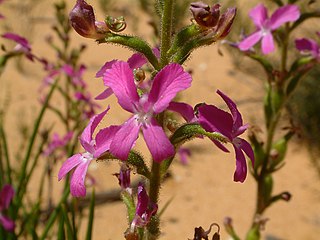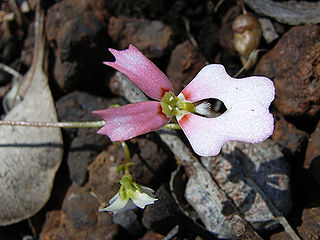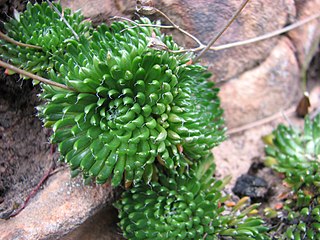
Stylidium is a genus of dicotyledonous plants that belong to the family Stylidiaceae. The genus name Stylidium is derived from the Greek στύλος or stylos, which refers to the distinctive reproductive structure that its flowers possess. Pollination is achieved through the use of the sensitive "trigger", which comprises the male and female reproductive organs fused into a floral column that snaps forward quickly in response to touch, harmlessly covering the insect in pollen. Most of the approximately 300 species are only found in Australia, making it the fifth largest genus in that country. Triggerplants are considered to be protocarnivorous or carnivorous because the glandular trichomes that cover the scape and flower can trap, kill, and digest small insects with protease enzymes produced by the plant. Recent research has raised questions as to the status of protocarnivory within Stylidium.

Stylidium scandens is a dicotyledonous plant that belongs to the genus Stylidium. S. scandens is endemic to Australia and is found primarily in the southwestern region of Western Australia. This species, along with Stylidium nymphaeum, has a unique characteristic among triggerplants in that its leaves, five centimetres long, end in a recurved barb that can grab hold of other vegetation and scramble or climb up to 30–60 cm in height over other plants, which is how it obtained its common name. Its flowers are bright pink and about 15 mm wide.

Stylidium alsinoides is a dicotyledonous plant that belongs to the genus Stylidium. It is an erect annual plant that grows from 18 to 30 cm tall. Obovate or elliptical leaves, about 20–100 per plant, are scattered along the elongate, glabrous stems. The leaves are generally 5.5–14 mm (0.22–0.55 in) long and 3–8 mm (0.12–0.31 in) wide. The bracts on the inflorescence can be as large as leaves and may be hard to distinguish them except for their growth habit: the leaves are alternate whereas the bracts are opposite.

Stylidium laricifolium, commonly known as giant trigger-plant, larch-leaf or tree triggerplant, or is a species of flowering plant in the family Stylidiaceae and is endemic to eastern Australia. It is a perennial subshrub with many linear leaves crowded along its few stems, the flowers white to pale pink and arranged in a single main panicle and smaller racemes.

Stylidium graminifolium, the grass triggerplant, is a dicotyledonous plant that belongs to the genus Stylidium. This species used to belong to the Stylidium graminifolium complex, but the name was conserved for this single species when two others were split from the complex and introduced as new species in 2001. S. graminifolium is endemic to Australia and is one of the Stylidium species with the widest distribution throughout Australia. It is a perennial plant with grass-like leaves and is easily cultivated. It has been considered to be a carnivorous or protocarnivorous plant because it possesses glandular trichomes underneath the flowers that can trap and digest prey.

Stylidium debile, commonly known as the frail triggerplant, is a carnivorous, dicotyledonous plant that belongs to the genus Stylidium. S. debile is endemic to coastal areas in Queensland and New South Wales, Australia.
Stylidium cordifolium is a dicotyledonous plant that belongs to the genus Stylidium. It is an erect annual plant that grows from 15 to 45 cm tall. Obovate or orbicular leaves, about 8-40 per plant, are scattered along the stems. The leaves are generally 3.5–8 mm long and about as wide. This species lacks a scape but has cymose inflorescences that are 4–13 cm long. Flowers are pink or red. S. cordifolium is found throughout tropical Australia, including northern Western Australia, in its typical habitat of swamp margins or moist sandy creekbanks. It flowers in the southern hemisphere from March to August. S. cordifolium is most closely related to S. javanicum, which has smaller leaves, sepals, capsules, and seeds. S. javanicum and S. cordifolium also differ in their distribution with S. javanicum's range not extending to Australia. Its conservation status has been assessed as data deficient.
Stylidium tenerrimum is a dicotyledonous plant that belongs to the genus Stylidium. It is an erect annual plant that grows from 4 to 30 cm tall. Linear, oblanceolate, or deltate leaves, about 5-24 per plant, are scattered along the stems. The leaves are generally 1.2-4.8 mm long and 0.3-0.8 mm wide. This species lacks a scape but has cymose inflorescences that are 4–11 cm long. Flowers are white and red. S. tenerrimum is found around Darwin in the Northern Territory of Australia and the Victoria River, though it hasn't been recollected there since the type location was chosen. Its typical habitat is sandy soils that remain moist, associated with grasses and sedges. It flowers in the southern hemisphere from April to August. S. tenerrimum is most closely related to S. alsinoides, though it differs by its asymmetrical petals. In his revision of the subgenus Andersonia in 2000, A.R. Bean placed S. evolutum into synonymy and noted that the type specimen of S. mitrasacmoides was not located and thus the application of this synonym is not certain. Tony Bean assessed this species' conservation status as data deficient in 2000.

Stylidium tenerum, the swamp triggerplant, is a dicotyledonous plant that belongs to the genus Stylidium that was described by Curt Polycarp Joachim Sprengel in 1826. Robert Brown had described this species in 1810 under the name S. tenellum, a name which had already been used for another species in 1805 by Olof Swartz. To add to the confusion, Rica Erickson had described and illustrated this taxon in 1958 under the name S. uliginosum, another currently accepted name for a related species.
Stylidium aquaticum is a dicotyledonous plant that belongs to the genus Stylidium. The specific epithet aquaticum refers to this species' typical habitat. It is an annual plant that grows from 18 to 30 cm tall. Linear leaves, about 20-100 per plant, are scattered along the elongate, glabrous stem. The leaves are generally 1.7–11 mm long and 0.1-0.3 mm wide. Petioles and scapes are absent. Inflorescences are 3–8 cm long. Flowers are pink or white. S. aquaticum is only known from its type location in northwestern Northern Territory of Australia. Its habitat is recorded as being a Melaleuca viridiflora swamp, growing in shallow water at a depth of around 7 cm. It flowers in the southern hemisphere in May. S. aquaticum is most closely related to S. fissilobum but differs mostly in the leaf shape. Its conservation status has been assessed as data deficient.
Stylidium prophyllum is a dicotyledonous plant that belongs to the genus Stylidium. It is an annual plant that grows from 8 to 30 cm tall. The deltate leaves, about 4-10 per plant, are scattered along the elongate, glabrous stem and are generally 0.7-1.5 mm long and 0.3-0.6 mm wide. Petioles and scapes are absent. Inflorescences are 3–14 cm long and produce pink flowers that bloom from February to June in the southern hemisphere. S. prophyllum is endemic to the area in and around the Kimberley region in Western Australia. Its habitat is recorded as being "grassy floodplains, seepage areas, and waterways." S. prophyllum is most closely related to S. fissilobum but differs mostly in its glabrous sepals.

Stylidium claytonioides is a dicotyledonous plant that belongs to the genus Stylidium. It is an annual plant that grows from 15 to 27 cm tall. The linear leaves, about 9-30 per plant, are mostly in terminal rosettes but with some scattered along the elongate, glabrous stem. The leaves are generally 12–24 mm long and 0.7–1 mm wide. Petioles are absent. This species produces one to six scapes per plant. Inflorescences are 10–18 cm long and produces a single pink and mauve flower that blooms from May to June in the southern hemisphere. S. claytonioides is endemic to the Kimberley region in Western Australia. Its habitat is recorded as being seasonal swamps near sandstone outcroppings and near creekbanks. Its conservation status has been assessed as data deficient.
Stylidium aceratum is a dicotyledonous plant that belongs to the genus Stylidium. It occurs within the south west region of Western Australia

Stylidium calcaratum, the book triggerplant, is a dicotyledonous plant that belongs to the genus Stylidium. It is an ephemeral annual that grows from 5 to 10 cm tall but can grow larger at 20–30 cm tall in damp forest or scrub habitat. The few ovate leaves produced by this plant form basal rosettes around the stem. The leaves are around 3–5 mm long on short petioles. The scapes are 2–30 cm tall and produce single flowers in smaller plants and up to nine flowers in larger, more robust plants. Flowers are pink or white with red spots or lines at the individual petal bases. The petals are vertically paired and will fold over to meet each other at night or in adverse weather conditions. S. calcaratum is endemic to Australia and has a distribution that ranges from Victoria through South Australia and into Western Australia. Its habitat is recorded as being wet flats or near creeks and seepages. Pollination is achieved by a grey fly, Comptosia cuneata.
Stylidium ceratophorum is a dicotyledonous plant that belongs to the genus Stylidium. It is an annual plant that is endemic to the Kimberley region of Western Australia and northern parts of the Northern Territory. It attains a height of 12–30 cm with a basal rosette of small leaves. The leaves are petiolate, obovate, or lanceolate and are only 0.2–1 cm long. Solitary scapes are produced that bear golden yellow or orange flowers, 7–9 mm across. Its habitat has been reported as being sandy soils on creek margins in the presence of Stylidium rubriscapum and Stylidium diceratum or in river paperbark stands. S. ceratophorum appears similar to S. diceratum and may be confused with the species since they both have orange flowers. S. ceratophorum's corolla is twice as large as S. diceratum, though, as well as the deeply divided posterior corolla lobes of S. ceratophorum.
Stylidium longicornu is a dicotyledonous plant that belongs to the genus Stylidium. It is an annual plant that grows from 10 to 30 cm tall. The obovate to spathulate leaves form a basal rosettes around the stem. The leaves are around 4–6 mm long. Inflorescences are unbranched racemes and produce flowers that are violet with white at the base and bloom from June to August in their native range. S. longicornu is endemic to the Kimberley region in Western Australia. Its habitat is recorded as being sand flats near sandstone. It grows in the presence of S. lobuliflorum, Rhynchospora, and Leptocarpus.
Stylidium paniculatum is a dicotyledonous plant that belongs to the genus Stylidium. It is an herbaceous annual that grows from 10 to 35 cm tall. Oblanceolate or obovate leaves, about 6-30 per plant, form either a basal rosette with stems absent or in terminal rosettes when plant stems are present. The leaves are generally 10–31 mm long and 3–9 mm wide. This species produces one scape per plant. Inflorescences are 10–25 cm long and produce pink flowers that bloom from November to April in their native range. S. paniculatum is endemic to eastern Australia from Dalveen, Queensland to Tenterfield, New South Wales at elevations of 800 to 1000 metres. Its typical habitat has been reported as moist sandy soils on granite substrates along creeks, drains, or low-lying flats. S. paniculatum is closely related to S. debile and was originally described as a variety of S. debile, but raised to the species level by Anthony Bean in 1999. It differs from S. debile by the lack of bracteoles and its paniculate inflorescence. Its conservation status has been assessed as data deficient.

Stylidium spathulatum is a dicotyledonous plant that belongs to the genus Stylidium. The species is informally named the creamy triggerplant for the colour of its flowers.

Stylidium soboliferum, commonly known as Grampians triggerplant or bristly triggerplant, is a species of flowering plant in the genus Stylidium. It is endemic to the Grampians region in Victoria, Australia. The leaves are about 1–2 centimetres (0.39–0.79 in) long and are arranged in a small rosette. The flowers, which appear on 5–15 centimetres (2.0–5.9 in) long stems, have white to pale pink petals with a darker colour on the reverse side. Plants occur along drainage lines and in moist areas amongst rocks.

Stylidium schoenoides is a species of dicotyledon plant of the Stylidium genus, from Stylidiaceae family, Asterales order, first described by Augustin Pyramus de Candolle in 1839. The plant is endemic to Western Australia.











